Peridot from the Central Highlands of Vietnam: Properties, Origin, and Formation
ABSTRACT
Vietnam is an important source of peridot for the international gem market. Gemological and geochemical characteristics of Vietnamese peridot from the Central Highlands are similar to those noted for other localities originating from xenoliths in alkaline basalts. This peridot was derived from a spinel lherzolite source and appeared to form at temperatures between 910° and 980°C and an assumed pressure of 2.0 ± 0.5 GPa, corresponding to a depth of around 60 km.
INTRODUCTION
Peridot is a yellowish green to green gem variety of the mineral olivine. It is found as nodules in igneous rocks, occasionally as crystals in veins (in Myanmar and Pakistan) or inside meteorites. The main sources are peridotite xenoliths in alkaline basalts and serpentinized dunites (Shen et al., 2011). Commercially important sources are Zabargad, Egypt; San Carlos, Arizona (United States); Myanmar; China; Kohistan, Pakistan; Vietnam; Ethiopia; and Tanzania. Many studies have focused on the characteristics of peridot from these sources (Gübelin, 1981; Koivula, 1981; Stockton and Manson, 1983; Koivula and Fryer, 1986; Fuhrbach, 1992; Sinkankas et al., 1992; Nassau, 1994; Kane, 2004; Adamo et al., 2009). Jan and Khan (1996) showed the gemological and chemical properties of peridot from Sapat Valley in Kohistan and suggested that its mineralization is related to post-tectonic hydrothermal activity. Bouilhol et al. (2012) proposed that the mineralization of peridot in Kohistan precipitated from subduction-derived fluids. Until now, though, geochemical characteristics, genesis, and P-T formation conditions of gem-quality peridot have received little attention.
Vietnamese peridot was discovered in the 1990s (Kammerling and Koivula, 1995). Since then, gem-quality material has been mined from three provinces in the Central Highlands: Gia Lai, Dak Nong, and Lam Dong (figure 1). The only active producer is Gia Lai, where two mines (Ham Rong and Bien Ho) yield more than 100 kg monthly; of that, 15%–20% is of gem quality (Huong et al., 2012). Mining is done mostly on a small scale by independent diggers, who extract the gem material from alluvial gravels or peridot nodules. In some places miners must dig pits three to five meters deep to reach the peridot-bearing alluvial layers. Jewelry featuring Vietnamese peridot has been on the domestic and international markets for more than a decade (Shigley et al., 2000; Long et al., 2004).
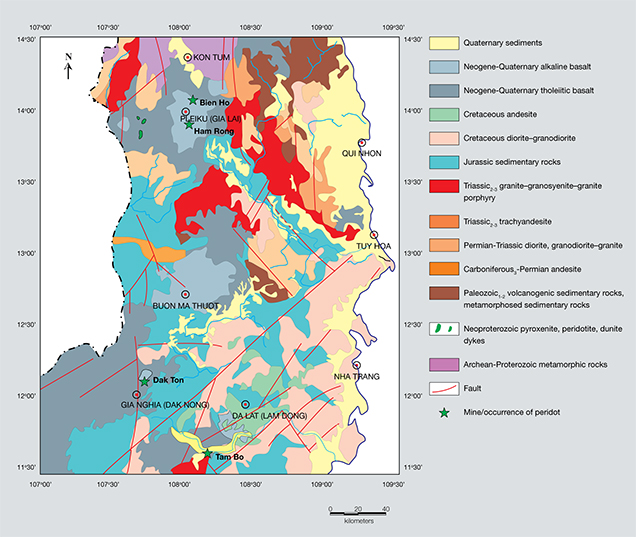
This paper presents gemological and geochemical characteristics of peridot from the Central Highlands. For the present study, the single-grain geothermometer used by De Hoog et al. (2010), using Al and Cr in olivine, was used to estimate the origin and P-T formation conditions. De Hoog et al. (2010) reported that concentrations of Al, Cr, V, Sc, Ca, and Na in olivine depend mainly upon temperature. The same study presented geothermometers based on the concentrations in garnet peridotite of Al in olivine, Cr in olivine, and Ca in olivine. They found that the most widely applicable of these is Al in olivine for garnet peridotites. Although the thermometers were calibrated with data for garnet peridotites, they also performed well for spinel peridotites.
BACKGROUND
The Central Highlands of Vietnam belong to a large-scale structure of the Truong Son orogenic belt, which is part of the Indochina block (Hoa et al., 2005). This region is composed of Archean-Proterozoic basement rocks and Early to Middle Paleozoic cover rocks. Basement rocks consist of granulite, amphibolite, and greenschist facies metamorphic rocks. Lying on these rocks are volcanogenic sedimentary rocks, metamorphosed sedimentary rocks of greenschist facies, and also sandstone, siltstone, and shale. Basement and cover rocks were intruded by granite, granodiorite, and granosyenite of Indosinian orogeny association (from Late Paleozoic to Triassic), as well as diorite and granodiorite of Cretaceous orogeny association (related to the Pacific subduction zone). The Early to Middle Paleozoic materials, and Carboniferous to Triassic rocks, were overlain by Jurassic, low-grade metamorphosed terrigenous sedimentary rocks. These older structures were eventually covered by Cenozoic magmatic formations.
Cenozoic magmatic formations belong to a basaltic series distributed in eastern and southeastern Asia, which developed after the end of the East Sea opening in the Middle Miocene (Barr and MacDonald, 1981; Taylor and Hayes, 1983). According to Hoang et al. (1996), basalt formations concentrated in the Central Highlands around several eruptive centers with different ages at Da Lat (13.3–7.9 Ma), Pleiku (<6.3–2.1 Ma), and Buon Ma Thuot (<6.3–1.63 Ma). Most of the centers appear to have developed during two eruptive episodes, separated by paleosol horizons half a meter to five meters in thickness. The early phase consisted of large volumes of quartz and olivine tholeiite flows erupted from extensional fissures. Eruptions of olivine tholeiite, alkaline basalt, and basanite along conjugate strike-slip faults comprised the latter phase. This two-phase pattern was repeated at Da Lat, Pleiku, and Buon Ma Thuot.
Peridot-bearing ultramafic nodules ranging from 5 to 40 cm are found essentially in alkaline basalts in the provinces of Gia Lai, Dak Nong, Lam Dong, and Ba Ria–Vung Tau (Quoc, 1995; Quoc et al. 1995). The peridot-bearing basalts were collected from the Bien Ho and Ham Rong mines in Gia Lai (figure 2). The basalts are dark gray, with phenocrysts in a homogeneous groundmass of acicular crystals. In this study, olivine, plagioclase, and iron hydroxides were found as phenocrysts (figure 3) in a matrix of trachytic texture consisting of plagioclase and iron hydroxides. Silica content was usually less than 52 wt.% and (Na2O + K2O) more than 5 wt.%. Also found in the area were some dykes of ultramafic rocks (peridotite, pyroxenite, and dunite) of Neoproterozoic age (Tinh et al., 1997).
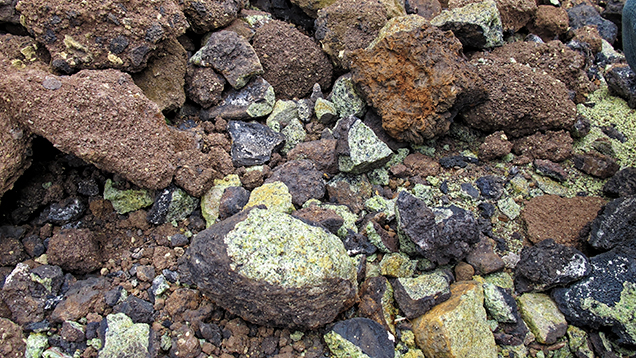
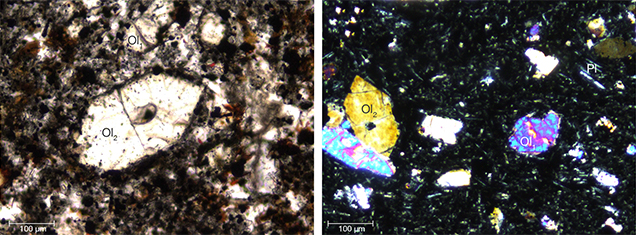
MATERIALS AND METHODS
For this study, we examined three gem-quality peridot nodules from the Ham Rong mine in Gia Lai Province (figure 4, left). Fourteen good-quality samples, 20 medium-quality samples, and 11 poor-quality samples were separated from the nodules (figure 4, top right); 15 stones were faceted and examined (figure 4, bottom right). Standard gemological testing was performed at DOJI Institute and Laboratory for Gemology and Jewelry in Hanoi to determine optical properties, hydrostatic specific gravity (SG), UV fluorescence, and microscopic features.

The selected rough stones were divided into three groups on the basis of their color and clarity (figure 4, top right). Nine of the best-quality peridot (from the lot on the left side of the photo), along with nine crystals of medium to good quality (from the middle lot) and two low-quality samples (from the lot on the right), were mounted and embedded in resin, polished, and analyzed by electron microprobe and laser ablation–inductively coupled plasma–mass spectrometry (LA-ICP-MS).
Electron microprobe analysis was performed at the Institute of Earth Sciences, Karl Franzens University of Graz, Austria. We used a JEOL JXA-8200 electron microprobe in wavelength-dispersive mode with an accelerating voltage of 15 kV, a beam current of 15 nA, count times of 60 seconds on peaks and 30 seconds on background, and a beam diameter of approximately 1 μm. The elements analyzed were Si, Fe, Mn, Mg, Ni, and Ca. Trace element analysis via LA-ICP-MS was carried out at NAWI Graz (a collaborative program jointly run by the University of Graz and Graz University of Technology) using an Agilent 7500 quadrupole coupled with an ESI NWR193 excimer laser source. The material was ablated with a 193 nm laser pulsed at 9 Hz with 75 µm spot size and a laser power corresponding to approximately 7.5 J/cm2. Helium 5.0 at an approximately 0.6 l/min flow rate was used as a carrier gas for the aerosol produced by laser ablation. Data was acquired in time-resolved analysis mode. The standard glasses NIST610 and NIST612 were routinely analyzed for standardization and drift correction. Standard glasses NIST614 and BCR-2G were analyzed as unknowns and allowed for replication with <10% relative error. Data reduction was performed with Glitter software (Macquarie University, Australia) using the concentration values of NIST610 and NIST612 from Jochum et al. (2011). Silicon was used as an internal standard.
Spectroscopy was performed at the Institute of Geosciences, Johannes Gutenberg University in Mainz, Germany. UV-Vis-NIR spectroscopic measurements were taken with a PerkinElmer Lambda 950 spectrophotometer, equipped with an integrating sphere and operating with a spectral resolution of 0.75 nm (for the 200–900 nm range) and 2.8 nm (for the 900–1600 nm range) at a 1 nm/minute scan rate.
RESULTS AND DISCUSSION
Gemological Characteristics. As shown in table 1, the Vietnamese samples showed gemological properties similar to those noted for peridot from other sources found in xenoliths within basalt (Gübelin, 1981; Koivula, 1981; Stockton and Manson, 1983; Koivula and Fryer, 1986; Fuhrbach, 1992; Kane, 2004; Adamo et al., 2009; Huong et al., 2012).
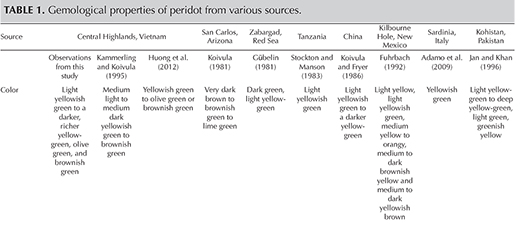
Crystal Morphology. No idiomorphic single crystals of rough peridot have been found in the Central Highlands deposits. Most Vietnamese peridot varies from several millimeters to 1.5 cm in diameter. Pieces as large as 4–6 cm are occasionally discovered (Thuyet et al., 2013).
Color. The samples ranged from a light yellowish green to a darker, richer yellow green, olive green, and brownish green. Faceted stones had an attractive yellowish green color (figure 4, right, and figure 5). Table 1 shows that the color of Vietnamese peridot is similar to material from Tanzania and Sardinia. In the samples we studied, diaphaneity ranged from translucent (due to high fracturing) to transparent.
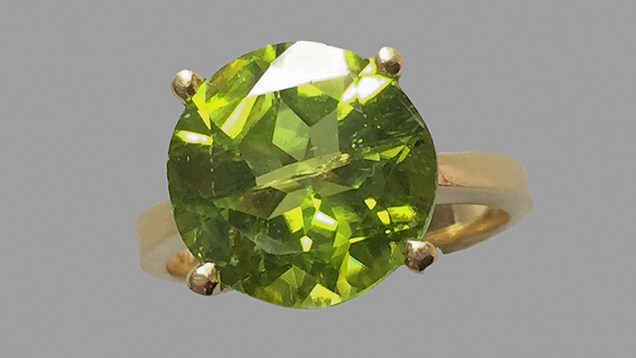
Optical Characteristics and Specific Gravity. Testing of the 24 samples indicated that both refractive index (RI) and SG varied slightly with color. The lightest-colored sample’s RI was α = 1.650, β = 1.665, and γ = 1.686, with a corresponding birefringence of 0.036. The darkest specimen had RIs of α = 1.667, β = 1.669, and γ = 1.703, with a birefringence of 0.036.
Specific gravity ranged from 3.28 to 3.49; the darker stones generally had a higher SG. The highest reading, 3.49, was obtained from a brownish green sample that contained numerous chromite octahedral inclusions (see figure 8). Chromite, with its SG of 4.50 to 5.09 (4.79 on average), was responsible for the higher than normal reading.
All of the stones were inert to both long- and short-wave UV radiation. To date, cat’s-eye and star peridot are not known from the Central Highlands.
The UV-Vis-NIR absorption spectra of five samples were characterized by a broad band at 1072 nm, with a shoulder at approximately 910 nm in the near-IR range, and an increasing absorption toward the UV region (figure 6). Weak bands were also observed at 374, 400, 438, 455, 484, and 625 nm. The bands at 455 and 484 nm were visible with a hand spectroscope as well, with total absorption below about 440 nm. This spectral feature is due to the presence of Fe2+ (Burns, 1970), confirming that iron is mainly responsible for the coloration.
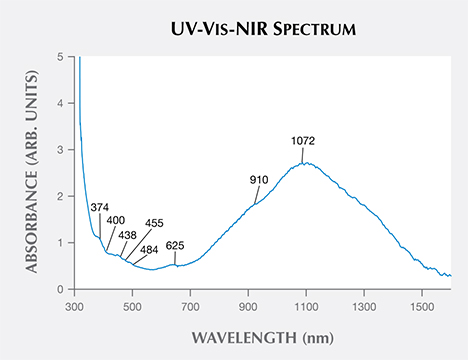
Internal Features. The internal features of Vietnamese peridot were similar to those found in xenoliths in alkaline basalts elsewhere (again, see table 1). The most prominent inclusions we observed were round, flat healing planes (disc-like “lily pads”) with a small opaque black crystal near the center (figure 7) and black opaque octahedral crystals of chromite surrounded by a tension halo (figure 8, left). Hercynite, a member of the spinel group, was sometimes observed (figure 8, right). This inclusion has only been reported in peridot from Kilbourne Hole, New Mexico (Fuhrbach, 1992). Partially healed secondary fractures with iridescence were seen in most of the Vietnamese samples (figure 9).
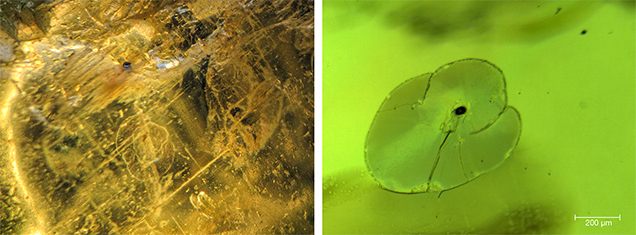
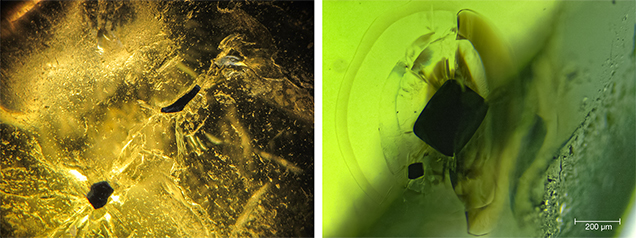
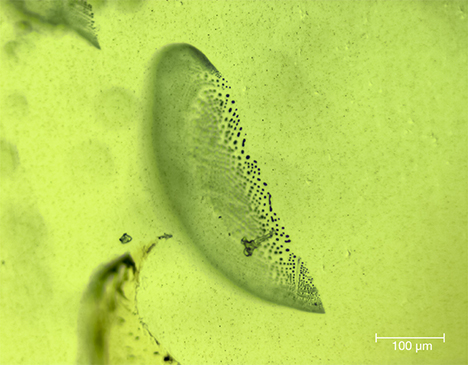
Chemical Composition. Major Elements. The average chemical composition obtained by electron microprobe is shown in table 2. The samples showed a very narrow range of magnesium content, with forsterite varying from 90.6 to 91.3 mol.%, which is typical for olivine/peridot from mantle sources. Most gem peridot lies within the Fo88–93 range (Jan and Khan, 1996) or Fo88.6–96.0 range (Shen et al., 2011), while olivine from peridotite xenoliths is in the Fo88.3–92.0 range (Embey-Isztin and Dobosi, 2007). Peridot samples from Gia Lai Province did not display the major-element zoning commonly observed in olivine from xenoliths, demonstrating their chemical equilibrium (De Hoog et al., 2010). MgO content varied in a narrow range from 47.22 to 52.25 wt.%, while FeO ranged from 8.24 to 9.90 wt.%, in agreement with data obtained by Huong et al. (2012), Quoc et al. (1995), and Y et al. (2006). Thus, FeO content in Vietnamese peridot was similar to that of samples from Sardinia, Myanmar, and San Carlos, Arizona, but higher than in samples from Tanzania and Zabargad. The FeO content range was not as wide as in samples from Kohistan, which varied from 2.74 to 9.69 wt.% and averaged 6.54 wt.%. The range of SiO2 content in our samples was similar to that of other peridot localities except Kohistan. There was no substantial difference in any of the remaining main elements (again, see table 2).

Trace Elements. De Hoog et al. (2010) divided trace elements in olivine into three distinct groups. Ni, Mn, Co, Cu, Zn, and Li, which make up Group I, exhibit small concentration ranges. Olivine is the primary host mineral. Group II, comprised of Cr, Al, V, Sc, Ca, and Na, is strongly concentrated in coexisting mantle minerals (garnet, clinopyroxene, and spinel) and shows a narrow range of bulk rock concentrations. Partition coefficients of Group II elements are highly temperature sensitive. Olivine shows the greatest level of variability, and the elements’ concentration ranges are mainly controlled by the host rock’s equilibration temperature. The concentration of the Group II elements in olivine allows the application of simple geothermometers. The Group III elements (Ti, Zr, Nb, and Y) are strongly dependent on bulk rock contents. These elements show large concentration ranges in olivine as well as in coexisting minerals (garnet, clinopyroxene, and spinel again). The trace-element composition of Vietnamese peridot samples, obtained by LA-ICP-MS analyses, is reported in table 3. In this study, Sc, Na, and Y were not analyzed. For comparison, table 3 also shows the composition of trace elements of Sardinian peridot originating from spinel lherzolite (Adamo, 2009), Kohistan peridot hosted by serpentinized dunites, and olivines from spinel and garnet lherzolite sources. Broadly speaking, the content of most trace elements in Vietnamese peridot is similar to that of Sardinian peridot and olivine originating from spinel lherzolite but different from that of Kohistan peridot (again, see table 3).
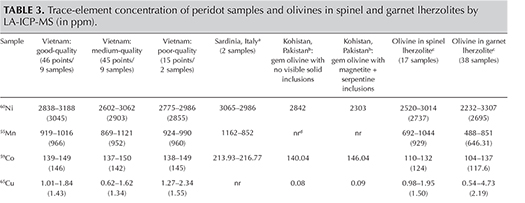
Ni contents ranged from 2602 to 3188 ppm (2934 ppm on average). Concentrations approximated those of peridot from Sardinia and olivine from spinel lherzolite but were higher than those of Kohistan peridot. Furthermore, Ni contents tended to be slightly higher in good-quality peridot than in medium- and poor-quality peridot. Cu concentrations ranged from 0.62 to 2.34 ppm (1.44 ppm on average). These values were typical for peridot from spinel lherzolite but different from those of Kohistan peridot. Li concentrations ranged from 1.22 to 1.93 ppm (1.45 ppm on average) and were similar to those of olivines from spinel and garnet lherzolite, slightly lower than Sardinian material, and much lower than in Kohistan peridot. Cr content varied from 72.4 to 126 ppm (100 ppm on average). This concentration was lower than in Sardinian peridot and olivine from garnet lherzolite sources but higher than in Kohistan peridot or olivine from spinel lherzolite. V ranged from 1.70 to 3.09 ppm (2.41 ppm on average). The samples were similar to olivines from spinel lherzolite sources and lower than the Sardinian peridot and olivine from garnet lherzolite sources but tended to be higher in vanadium content than Kohistan peridot. Ti concentrations ranged from 5.55 up to 37.0 ppm with 11.7 ppm on average. These values were similar to those of Sardinian peridot and lower than those of olivine from spinel and garnet peridotites but slightly higher than in Kohistan peridot. Ca concentration ranged from 11.4 to 782 ppm. The range is similar to olivine derived from spinel and garnet lherzolite. Most of the good- and medium-quality samples analyzed contained approximately 300 ppm of Ca. However, Ca content in the low-quality peridot ranged from 11.4 to 13.9 ppm (12.6 ppm on average), similar to Kohistan peridot.
Source and Formation Conditions. Lithological Information. Previous studies based on mineral assemblages coexisting paragenetically, either with olivine in nodules in alkaline basalts or with peridot in placers, have identified the source of Vietnamese peridot as lherzolite xenoliths (Quoc, 1995; Quoc et al., 1995; Toan and Ty, 1995; Long et al., 2004). In those previous works, however, the trace-element composition of minerals and rocks was not used to pinpoint their source. In this study, LA-ICP-MS analysis was used to determine trace elements in Vietnamese peridot. The results indicated that, in terms of trace elements, Vietnamese peridot is similar to peridot and olivine from the spinel lherzolite field. Furthermore, when using Al-Mn discrimination diagrams of De Hoog (2010) for petrological classification of mantle lithologies, Vietnamese peridot always falls into the spinel lherzolite field (figure 10).
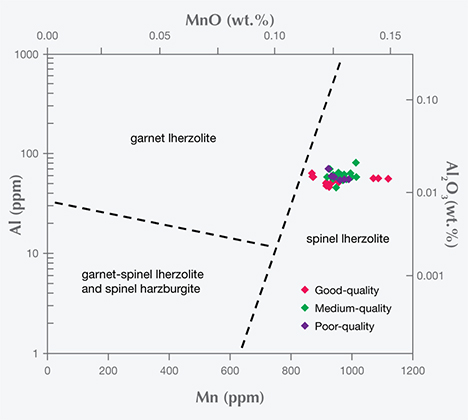
P-T Conditions. To demonstrate that olivine’s variations in trace elements are determined by temperature (and to some extent pressure), De Hoog (2010) calculated olivine mineral partition coefficients for Group II elements using multiple linear regression analysis. Strong temperature correlations confirmed the temperature-sensitive nature of these elements, as expressed in formulas [1] and [2]:

where [Al]ol is the Al content of olivine in ppm, and Cr#ol is Cr/(Cr + Al) of olivine in atoms.

where [Cr]ol is the Cr content of olivine in ppm.
Using the Al [1] and Cr [2] single-grain thermometer from De Hoog et al. (2010), temperature values between 910°C and 980°C can be calculated, assuming a pressure of 2.0 Gpa. This corresponds to a depth of around 60 km and is within the stability field of a spinel lherzolite. The Cr-in-olivine thermometer consistently gave a temperature 14–17°C higher than the Al in olivine values (figure 11). The average temperatures of good-, medium-, and poor-quality peridot from the Cr and Al single-grain thermometer were calculated as:
| Good-quality | Medium-quality | Poor-quality | |
| Cr | 963°C | 950°C | 957°C |
| Al | 940°C | 933°C | 940°C |
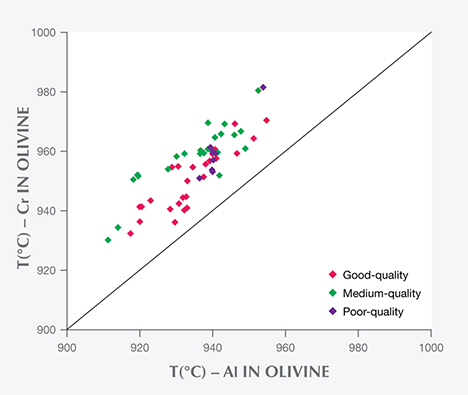
CONCLUSIONS
Chemical analysis demonstrated that the FeO content in Vietnamese peridot is similar to that of peridot from Sardinia, Myanmar, and Arizona, and higher than that of peridot from Tanzania and Zabargad. Pakistani peridot’s FeO content was generally lower and more varied. The material’s gemological characteristics were similar to those noted for peridot from other localities that originated from xenoliths in alkaline basalts, especially the color of previously studied samples from Tanzania and Italy. Trace-element concentrations corresponded to those of olivine derived from spinel lherzolites. The low-quality Vietnamese samples usually had a lower Ca content than all other Vietnamese peridot.
The results of this study indicate that peridot from the Central Highlands of Vietnam formed at temperatures between 910°C and 980°C and at an assumed pressure of 2.0 ± 0.5 GPa, which corresponds to a depth of around 60 km.
.jpg)


